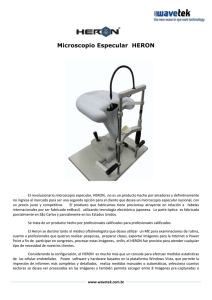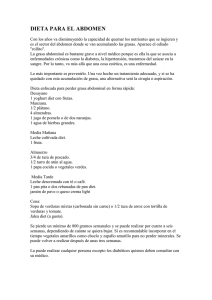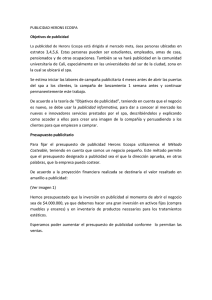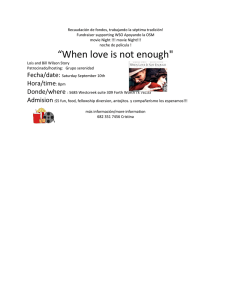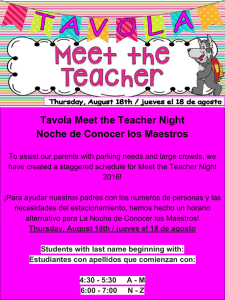the diet of the night heron and purple heron in the guadalquivir
Anuncio
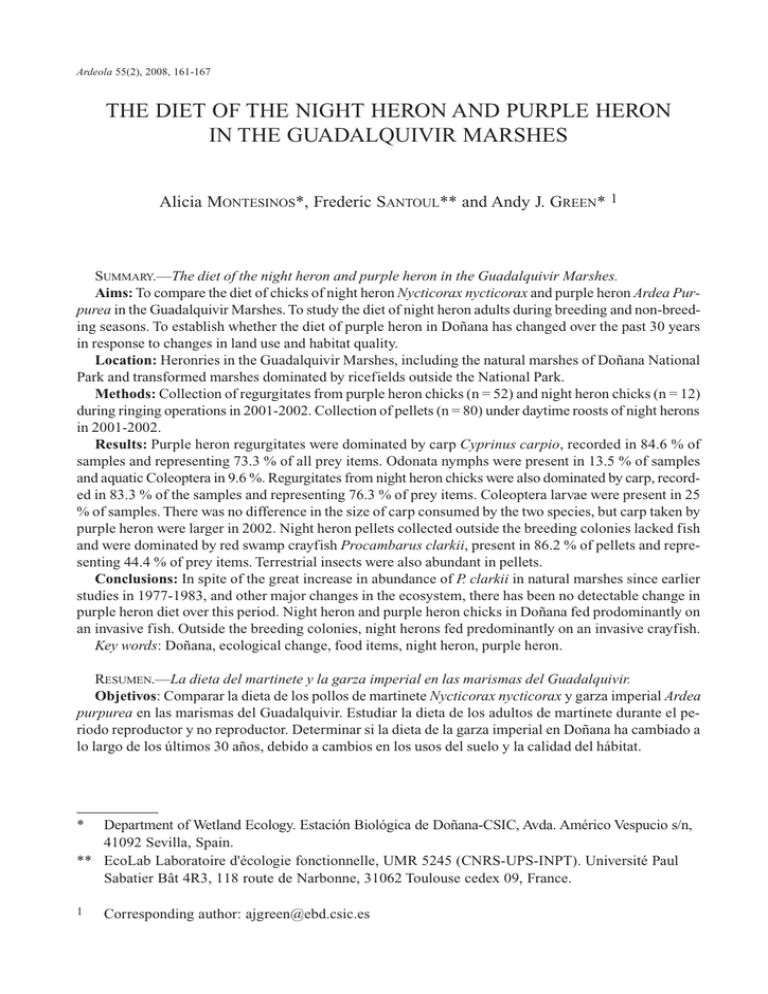
Ardeola 55(2), 2008, 161-167 THE DIET OF THE NIGHT HERON AND PURPLE HERON IN THE GUADALQUIVIR MARSHES Alicia MONTESINOS*, Frederic SANTOUL** and Andy J. GREEN* 1 SUMMARY.—The diet of the night heron and purple heron in the Guadalquivir Marshes. Aims: To compare the diet of chicks of night heron Nycticorax nycticorax and purple heron Ardea Purpurea in the Guadalquivir Marshes. To study the diet of night heron adults during breeding and non-breeding seasons. To establish whether the diet of purple heron in Doñana has changed over the past 30 years in response to changes in land use and habitat quality. Location: Heronries in the Guadalquivir Marshes, including the natural marshes of Doñana National Park and transformed marshes dominated by ricefields outside the National Park. Methods: Collection of regurgitates from purple heron chicks (n = 52) and night heron chicks (n = 12) during ringing operations in 2001-2002. Collection of pellets (n = 80) under daytime roosts of night herons in 2001-2002. Results: Purple heron regurgitates were dominated by carp Cyprinus carpio, recorded in 84.6 % of samples and representing 73.3 % of all prey items. Odonata nymphs were present in 13.5 % of samples and aquatic Coleoptera in 9.6 %. Regurgitates from night heron chicks were also dominated by carp, recorded in 83.3 % of the samples and representing 76.3 % of prey items. Coleoptera larvae were present in 25 % of samples. There was no difference in the size of carp consumed by the two species, but carp taken by purple heron were larger in 2002. Night heron pellets collected outside the breeding colonies lacked fish and were dominated by red swamp crayfish Procambarus clarkii, present in 86.2 % of pellets and representing 44.4 % of prey items. Terrestrial insects were also abundant in pellets. Conclusions: In spite of the great increase in abundance of P. clarkii in natural marshes since earlier studies in 1977-1983, and other major changes in the ecosystem, there has been no detectable change in purple heron diet over this period. Night heron and purple heron chicks in Doñana fed prodominantly on an invasive fish. Outside the breeding colonies, night herons fed predominantly on an invasive crayfish. Key words: Doñana, ecological change, food items, night heron, purple heron. RESUMEN.—La dieta del martinete y la garza imperial en las marismas del Guadalquivir. Objetivos: Comparar la dieta de los pollos de martinete Nycticorax nycticorax y garza imperial Ardea purpurea en las marismas del Guadalquivir. Estudiar la dieta de los adultos de martinete durante el periodo reproductor y no reproductor. Determinar si la dieta de la garza imperial en Doñana ha cambiado a lo largo de los últimos 30 años, debido a cambios en los usos del suelo y la calidad del hábitat. * Department of Wetland Ecology. Estación Biológica de Doñana-CSIC, Avda. Américo Vespucio s/n, 41092 Sevilla, Spain. ** EcoLab Laboratoire d'écologie fonctionnelle, UMR 5245 (CNRS-UPS-INPT). Université Paul Sabatier Bât 4R3, 118 route de Narbonne, 31062 Toulouse cedex 09, France. 1 Corresponding author: ajgreen@ebd.csic.es 162 MONTESINOS, A., SANTOUL, F. and GREEN, A. J. Localidad: Colonias y dormideros de garzas en las marismas del Guadalquivir, incluyendo marismas naturales del Parque Nacional de Doñana y marismas transformadas principalmente en arrozales fuera del Parque Nacional. Métodos: Recogida de regurgitados de pollos de garza imperial (n = 52) y de martinete (n = 12) durante los anillamientos de 2001-2002. Recogida de egagrópilas (n = 80) bajo los dormideros de martinete en 2001-2002. Resultados: En los regurgitados de garza imperial predominó la carpa Cyprinus carpio, detectada en el 84.6 % de las muestras y representando el 73.3 % de las presas detectadas. Las ninfas de Odonatos estuvieron presentes en el 13.5% de las muestras y coleópteros acuáticos en el 9.6 %. En los regurgitados de pollos de martinete también predominó la carpa, registrada en el 83.3 % de las muestras y representando el 76.3 % de las presas. Se encontraron larvas de coleópteros en el 25 % de las muestras. No se encontraron diferencias en el tamaño de las carpas consumidas por ambas especies, pero las carpas consumidas por garza imperial fueron de mayor tamaño en 2002. En las egagrópilas recogidas en lugares alejados de las colonias de cría no aparecieron peces y predominó el cangrejo americano P. clarkii, presente en el 86.2 % de las egagrópilas y representando el 44 % de las presas. En las egagrópilas, los insectos terrestres también fueron abundantes. Conclusiones: A pesar del gran incremento en abundancia que ha experimentado P. clarkii en las marismas naturales desde los primeros estudios en 1977-1983, otros cambios significativos en este ecosistema, no se ha producido una variación detectable en la dieta de la garza imperial en este periodo. Los pollos de martinete y garza imperial se alimentaron principalmente de una especie piscícola invasora. Fuera de las colonias de cría, el martinete se alimentó en gran medida del cangrejo invasor. Palabras clave: Doñana, cambio ecológico, componentes de la dieta, martinete, garza imperial. INTRODUCTION In years of high rainfall, the Guadalquivir Marshes (or Doñana Marshes) are the most important breeding site in the Iberian Peninsula for the night heron Nycticorax nycticorax and the purple heron Ardea Purpurea (Martí and del Moral, 2003). However, there is no pre-existing information on the diet of the night heron in the Guadalquivir Marshes. Previous data on the diet of purple heron were collected several decades ago (Amat and Herrera, 1978; Rodríguez de los Santos and Canavate, 1985). Since then, the marshes have been subjected to considerable ecological change owing to water extraction, pollution and invasion of exotic species, as well as transformation of natural marshes into ricefields and fish ponds (García-Novo and Marín, 2005; Fernández-Delgado, 2006; Rendón et al., 2008). A study of the diet of these two species in 2001-2002 is presented. The diet of night herons is quantified inside and outside the breeding Ardeola 55(2), 2008, 161-167 season. The diet of purple heron chicks is also quantified, searching for possible changes over time in response to habitat transformation and changes in the abundance and distribution of different prey items. One important change is the invasion by the red swamp crayfish Procambarus clarki which was introduced into Spain in 1973 but did not become abundant in Doñana until around 1984 (F. Hiraldo, unpubl. data). This crayfish can be a major prey item for waterbirds (Correia, 2001), but can also have a negative impact on the abundance of alternative invertebrate prey (Gutiérrez-Yurrita et al., 1998; Geiger et al., 2005). METHODS Diet samples were collected from different localities within the Guadalquivir Marshes (GM from heron) where Ardea purpurea and Nycticorax nycticorax established breeding colonies or day-time roosts in 2001 or 2002. Regurgi- THE DIET OF HERONS IN GUADALQUIVIR MARSHES tates were collected from A. purpurea chicks in June-July 2001 and May-July 2002, and from N. nycticorax chicks in July 2001 during ringing operations. They were collected from four sites within Doñana National Park and surrounded by natural marshes: Lucio de la FAO, Caño del Guadiamar, Juncabalejo and Huerto de los Zorros. One A. purpurea regurgitate was also collected outside the National Park, from the Brazo del Este. Pellets discharged by adult or juvenile night herons were also collected from under daytime roosts in June and September 2001, and in January and March 2002. They were collected both inside the National Park (at the Lucio del Bolín) and outside (from Isla Mayor, Isla Menor, Casa Nieves and Cortijo del Olivillo). All sites outside the National Park consisted of small areas of trees or reedbeds surrounded mainly by ricefields. In 2001, an estimated 2,000-2,100 pairs of N. nycticorax and 1,400-1,500 pairs of A. purpurea bred in GM. In 2002, an estimated 1,9301,960 pairs of N. nycticorax and 1,200-1,300 pairs of A. purpurea bred in GM. Unlike purple heron, considerable numbers of night herons overwinter in Doñana, with an estimated 1,120 present in the winter of 2001-2002 (unpublished census data from the Estación Biológica de Doñana, see http://wwwrbd.ebd.csic.es/Seguimiento/seguimiento.htm) All diet samples were frozen and then later washed in a 1mm sieve before identifying prey items with a binocular microscope. Carp Cyprinus carpio were usually present whole in regurgitates and were measured to the nearest 5 mm. In cases where only the head of a fish was present, measurements of whole fish were used to estimate total length. The differences in length of C. carpio eaten in different years (in 2001 and 2002, by A. Purpurea) and by different heron species were compared (A. purpurea and N. Nycticorax, in 2001). In order to avoid pseudo-replication, the median length of fish for each sample was first calculated and these medians compared with a Mann-Whitney U test using SPSS 13.0 software. 163 RESULTS Regurgitates from purple heron chicks in Doñana National Park were dominated by carp, recorded in 84.6% of the samples and representing 73.3 % of all prey items (table 1). Insects were also frequent, particularly Odonata nymphs and Coleoptera, present in 13.5 % and 9.6 % of regurgitates respectively. The red swamp crayf ish P. clarkii was only recorded in one of 52 samples. Coot F. atra chicks and sharp-ribbed salamanders P. waltl were found in one and three samples respectively. There were no obvious differences in composition between years. The only sample collected from outside the National Park contained a brown rat Rattus norvegicus (table 1). Regurgitates from night heron chicks in Doñana National Park were generally similar to those from purple herons and were also dominated by carp, recorded in 83.3 % of the samples and representing 76.3 % of prey items (table 1). Coleoptera larvae were present in 25 % of samples. Pellets collected from adult night herons were very different, with an absence of fish and a dominance of P. clarkii both inside and outside the National Park (table 1). P. clarkii were present in 86.2% of pellets and represented 44.4 % of prey items. Terrestrial insects such as earwigs (Forficulidae), ground beetles (Carabidae), tiger beetles (Cincindelidae), Hymenoptera and the field cricket Gryllus campestris were also abundant in pellets. In 2001, the size of carp in regurgitates of A. purpurea and N. Nycticorax was relatively small, with no individuals longer than 11 cm (fig. 1) and no significant difference in size between heron species (Mann-Whitney U test, N = 8, 10, U =2 8.5, p = 0.3). In contrast, there was a highly significant difference between years in the size of fish in A. purpurea regurgitates, owing to the presence of larger fish of 15.5-23.0 cm in 2002 (fig. 1; n = 8, 36; U = 58; p = 0.009). Ardeola 55(2), 2008, 161-167 164 MONTESINOS, A., SANTOUL, F. and GREEN, A. J. TABLE 1 Frequency of occurrence of different prey items in chick regurgitates of Ardea purpurea and chick regurgitates and adult pellets of Nycticorax nycticorax from inside and outside Doñana National Park. The first figure represents the percent occurrence (% of samples in which the item was recorded). The second figure in parentheses represents the total number of prey items. * indicates aquatic insects. [Frecuencia de presencia de las diferentes presas en los regurgitados de pollos de Ardea purpurea y regurgitados de pollos y egagrópilas de adultos de Nycticorax nycticorax en las colonias y dormideros de dentro y fuera del Parque Nacional de Doñana. El primer valor representa el porcentaje de presencia (el % de las muestras en las que se ha registrado cada presa). El segundo valor, entre paréntesis, representa el número total de presas. * indica insecto acuático.] Regurgitates A. purpurea Crustaceans Procambarus clarkii Insects Coleoptera Larvae Cybister sp. * Larvae Dryops sp. * Adult unid. Larvae unid. Cincindelidae larvae Carabidae Odonata Aeshnidae nymphs * Diptera Tabanidae Orthoptera Acrididae Gryllus campestris Unid. Dermaptera Forficulidae HymenopteraUnid. Unid. Cyprinus carpio Fishes Amphibians Pleurodeles waltl Birds Fulica atra Rattus norvegicus Mammals Total prey items OUT n=1 IN n = 12 2.0 (2) 27.4(55) 9.8(25) 7.8(24) 2.0(1) . . . . 13.7(21) 2.0(8) . . . . . . . . . . . 8.3(1) 25.0(21) 25.0(21) 16.7(18) . . 8.3(3) . . . . . . . . . . . 83.3(71) . . . 93 2.0(1) . . . . . . . . . . . . 86.3(170) 5.9(3) . 2.0(1) . . 100.0(1) 1 231 The diet of purple heron and night heron chicks was very similar with a dominance of carp of a similar size. Although biomass was Ardeola 55(2), 2008, 161-167 N. nycticorax IN n = 51 DISCUSSION Pellets N. nycticorax IN n = 15 OUT n = 65 66.7(11) 90.8(89) 86.6(22) 18.5(102) 53.3(16) 6.1(6) 13.3(2) . . . 6.7(1) . 26.7(11) . . 3.1(2) 6.7(2) 3.1(4) . . . . . . . . 3.1(12) 13.2(2) . . 3.1(64) 6.7(1) 6.1(20) 20.0(3) . . . . . . . . . 33 191 not quantified directly, it was obvious that carp represented over 80 % of ingested biomass for both bird species. The diet of both species contrasts with that of glossy ibis Plegadis falcinellus chicks in the same colonies, which is dom- THE DIET OF HERONS IN GUADALQUIVIR MARSHES 165 FIG. 1.—Sizes of carp Cyprinus carpio present in Ardea purpurea and Nycticorax nycticorax regurgitates. The size class represents fish measured as 40 or 45 mm, etc. [Tamaño de las carpas (Cyprinus carpio) presentes en los regurgitados de Ardea purpurea y Nycticorax nycticorax. La clase de tamaño representa a los peces medidos como 40 o 45mm, etc.] inated by aquatic Coleoptera and Odonata nymphs with few carp (Macías et al., 2004). The carp is an exotic species in Spain first introduced in the 16th century (Fernández-Delgado, 1990), and its introduction is believed to have had a profound effect on native fish and on the entire GM ecosystem. There is a striking lack of diversity of fish species in the diet of herons from the natural GM marshes compared with other areas (Amat and Herrera, 1978; Pérez et al., 1991). This represents the first study of the diet of night heron from south-western Spain, and one of the first studies from the Mediterranean region to include data from outside the breeding season (see also Correia, 2001). Night heron chicks were also found to feed predominantly on carp and Coleoptera in the Ebro Delta (Martínez et al., 1992). Adult night herons were found to be partly dependent on terrestrial insects taken at marsh or ricefield edges during nocturnal feeding, and possibly from trees while roosting during the day. Terrestrial prey were also abundant in previous studies of night heron chicks (Kazantzidis and Goutner, 2005; Martínez et al., 1992; Hafner, 1977). These results for purple heron chicks in the natural marshes are very similar to those obtained in 1977-1983 (Amat and Herrera, 1978; Rodríguez de los Santos and Canavate, 1985), who found chicks were fed mainly on carp, followed by Coleoptera larvae (Cybister spp). Rodríguez de los Santos and Canavate (1985) found differences in purple heron diet between the Brazo del Este (an area of transformed marshes) and the natural GM marshes consistent with the results given here. For example, this earlier study and the present one suggest that rats are regular prey items outside the National Park. No evidence was found of an important change over time in purple heron diet, despite the fact that the exotic crayfish P. clarkii has become extremely abundant in the natural GM marshes over this period (Gutiérrez-Yurrita et al., 1998). P. clarkii was already recorded in small numbers in chick reArdeola 55(2), 2008, 161-167 166 MONTESINOS, A., SANTOUL, F. and GREEN, A. J. gurgitates from the Brazo del Este in 1983 (Rodríguez de los Santos and Canavate, 1985). In the Camargue, the proportion of insects in the diet of purple heron chicks has increased over time, while the proportion of fish has decreased, although the reasons for this remain unclear (Barbraud et al., 2001). The diet of the squacco heron Ardeola ralloides in the Camargue has also changed markedly since the 1970s (Delord et al., 2004). The similarity in size of carp taken by the two heron species in 2001, combined with the difference between years in the size taken by purple herons, suggests that the herons responded to changes in the abundance of different size classes of fish. The bimodal distribution in 2002 indicates the presence of both young-of-the year (0+) and older age classes (see Fernández-Delgado, 1990). Temporal variation in the size of carp available in the GM is also indicated by a marked contrast between our study and that of Rodríguez de los Santos and Canavate (1985), who found fish of < 8 cm to be absent from the diet of purple heron chicks in 1983, with a modal size of 12-14 cm. However, they also found evidence that herons selected carp of 1030 cm and avoided smaller or larger fish, and that larger chicks eater larger fish. The size of carp taken by purple herons can also vary from one part of the breeding season to another (Campos and Lekuona, 1997). The near absence of red swamp crayfish in chick diet is surprising given their abundance in GM and the fact that crayfish represented the majority of ingested biomass for adult night herons in roosts both inside and outside the national park. These results suggest that adult night herons feed heavily on crayfish throughout the annual cycle and crayfish have also been found elsewhere to be a major prey for adult purple herons (Correia, 2001). Similarly, glossy ibis adults away from the colony at GM consume far more crayfish than do their chicks (Macías et al., 2004). Thus, it seems adult herons are less likely to feed crayfish to their chicks than to select them for themselves, perArdeola 55(2), 2008, 161-167 haps because they are relatively hard for chicks to swallow or digest. Crayfish were also relatively rare in the diet of night heron chicks compared to adults in previous studies elsewhere (Martínez et al., 1992; Correia, 2001). In conclusion, chicks of both heron species feed predominantly on an exotic fish (carp) and adult night herons on an exotic crayfish. Aquatic insects are of secondary importance for chicks, and terrestrial insects for adult night herons. The reasons for the low frequency of crayfish in the diet of chicks should be addressed in future research. ACKNOWLEDGEMENTS.—Samples were collected by F.G. Vilches and loaned by F. Hiraldo under the framework of National Parks project 96B/2002 financed by the Ministry of Environment. The Equipo de Seguimiento de Procesos Naturales of the EBD helped in sample collection and conducted censuses of the heron populations. H. Rodríguez-Pérez helped in the identification of invertebrates. BIBLIOGRAPHY AMAT, J.A. and HERRERA, C. M. 1978. Alimentación de la Garza Imperial (Ardea purpurea) en las Marismas del Guadalquivir durante el periodo de nidificación. Ardeola, 24: 95-104. BARBRAUD, C., LEPLEY, M., LEMOINE, V. and HAFNER, H. 2001. Recent changes in the diet and breeding parameters of the Purple Heron Ardea purpurea in southern France. Bird Study, 48: 308-316. CAMPOS, F. and LEKUONA, J. M. 1997. Temporal variations in the feeding habits of the Purple Heron Ardea purpurea during the breeding season. Ibis, 139: 447-451. CORREIA, A. M. 2001. Seasonal and interspecific evaluation of predation by mammals and birds on the introduced red swamp crayfish Procambarus clarkii (Crustacea, Cambaridae) in a freshwater marsh (Portugal). Journal of Zoology of London, 255: 533-541. DELORD, K., KAYSER,Y., COHEZ, D., BEFELD, S. and HAFNER, H. 2004. Fluctuations in chick diet of the Squacco Heron Ardeola ralloides in southern THE DIET OF HERONS IN GUADALQUIVIR MARSHES France: changes over the last 30 years. Bird Study, 51: 69-75. FERNÁNDEZ-DELGADO, C. 1990. Life history patterns of the common carp, Cyprinus Carpio, in the estuary of the Guadalquivir river in southwest Spain. Hydrobiologia, 206: 19-28. FERNÁNDEZ-DELGADO, C. 2006. Conservation management of a European natural area: Doñana National Park, Spain. In: Principles of conservation biology, Third Edition (Ed. by Groom, M. J., Meffe, G. K. and Carroll, C. R.), pp. 536-543. Sinauer Associates. Sunderland, Massachusetts. GARCÍA-NOVO, F. and MARÍN, C. 2005. Doñana, Water and Biosphere. Confederación Hidrográfica del Guadalquivir, Ministerio de Medio Ambiente. http://www.unesco.org/mab/publications/pdf/E_ Donana.pdf GEIGER, W., ALCORLO, P., BALTANÁS, A. and MONTES, C. 2005. Impact of an introduced Crustacean on the trophic webs of Mediterranean wetland. Biological Invasions, 7: 49-73. GUTIÉRREZ-YURRITA, P. J., SANCHO, G., BRAVO, M. A., BALTANÁS, A. and MONTES, C. 1998. Diet of the red swamp crayfish Procambarus clarkii in natural ecosystems of the Doñana National Park temporary fresh-water marsh (Spain). Journal of Crustacean Biology, 18: 120-127. HAFNER, H. 1977. Contribution à l’etude écologique de quatre espèces de héroes, Egretta garzetta, Ardeola ralloides, Ardeola ibis, Nycticorax nycticorax. Thèse, université. Toulouse. 167 KAZANTZIDIS, S. and GOUTNER, V. 2005. The diet of nestlings of three Ardeidae species (Aves, Ciconiiformes) in the Axios Delta, Greece. Belgian Journal of Zoology, 135: 165-170 MACÍAS, M., GREEN, A. J. and SÁNCHEZ, M. I. 2004. The diet of the Glossy Ibis during the breeding season in Donana, southwest Spain. Waterbirds, 27: 234-239. MARTÍ, R. and DEL MORAL, J. C. 2003. Atlas de las aves reproductoras de España. Dirección General de Conservación de la Naturaleza-Sociedad Española de Ornitología. Madrid. MARTÍNEZ, C., RUIZ, X. and JOVER, L. 1992. Food of night heron chicks Nycticorax nycticorax in the Ebro Delta. Ardeola, 39: 25-34. PÉREZ, J. J., LOPE, F. DE, TUREJANO, B. and DE LA CRUZ, C. 1991. The food of Black-crowned night heron nestlings in Extremadura (W. Spain). Ardeola, 38: 277-287. RENDON, M. A., GREEN, A .J., AGUILERA, E. and ALMARAZ, P. 2008. Status, distribution and long-term changes in the waterbird community wintering in Doñana, south-west Spain. Biological Conservation, 141: 1371-1388. RODRÍGUEZ DE LOS SANTOS, M. and CANAVATE J. P. 1985. Sélection des proles par le Héron pourpré Ardea purpurea pendant la période de reproduction dans les marais du Guadalquivir (Espagne). L’Oiseau et R.F.O., 55: 195-203. [Recibido: 26-09-08] [Aceptado: 4-11-08] Ardeola 55(2), 2008, 161-167
